Employability Skills Report: Enhancing Career Prospects and Skills
VerifiedAdded on 2021/04/17
|20
|2779
|355
Report
AI Summary
This report delves into the essential aspects of employability skills, focusing on self-awareness and career preparation within the human resource management sector. It explores the benefits of networking, including reassessing qualifications and uncovering hidden job opportunities, and discusses the Holland's theory of career choice. The report analyzes the value of a BSc in Human Resource Management in developing crucial job skills and examines the Chartered Institute of Personnel Development (CIPD) qualification. It also provides a job description of a Human Resource Officer, highlighting the required skills, and assesses the author's LinkedIn profile and CV in relation to the position. Finally, it reflects on interview experiences using the STAR method, offering a comprehensive overview of career development and job application strategies.
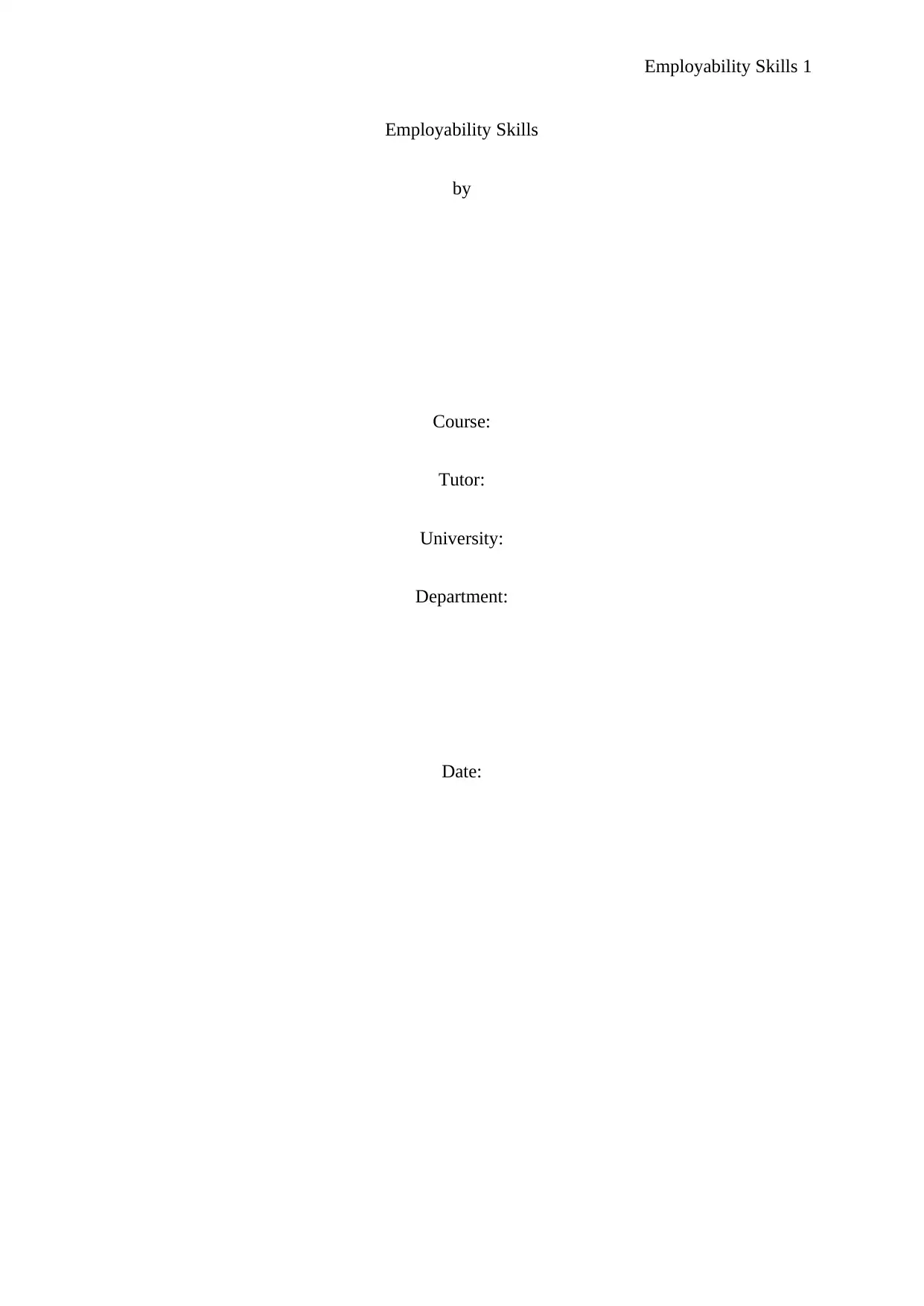
Employability Skills 1
Employability Skills
by
Course:
Tutor:
University:
Department:
Date:
Employability Skills
by
Course:
Tutor:
University:
Department:
Date:
Paraphrase This Document
Need a fresh take? Get an instant paraphrase of this document with our AI Paraphraser
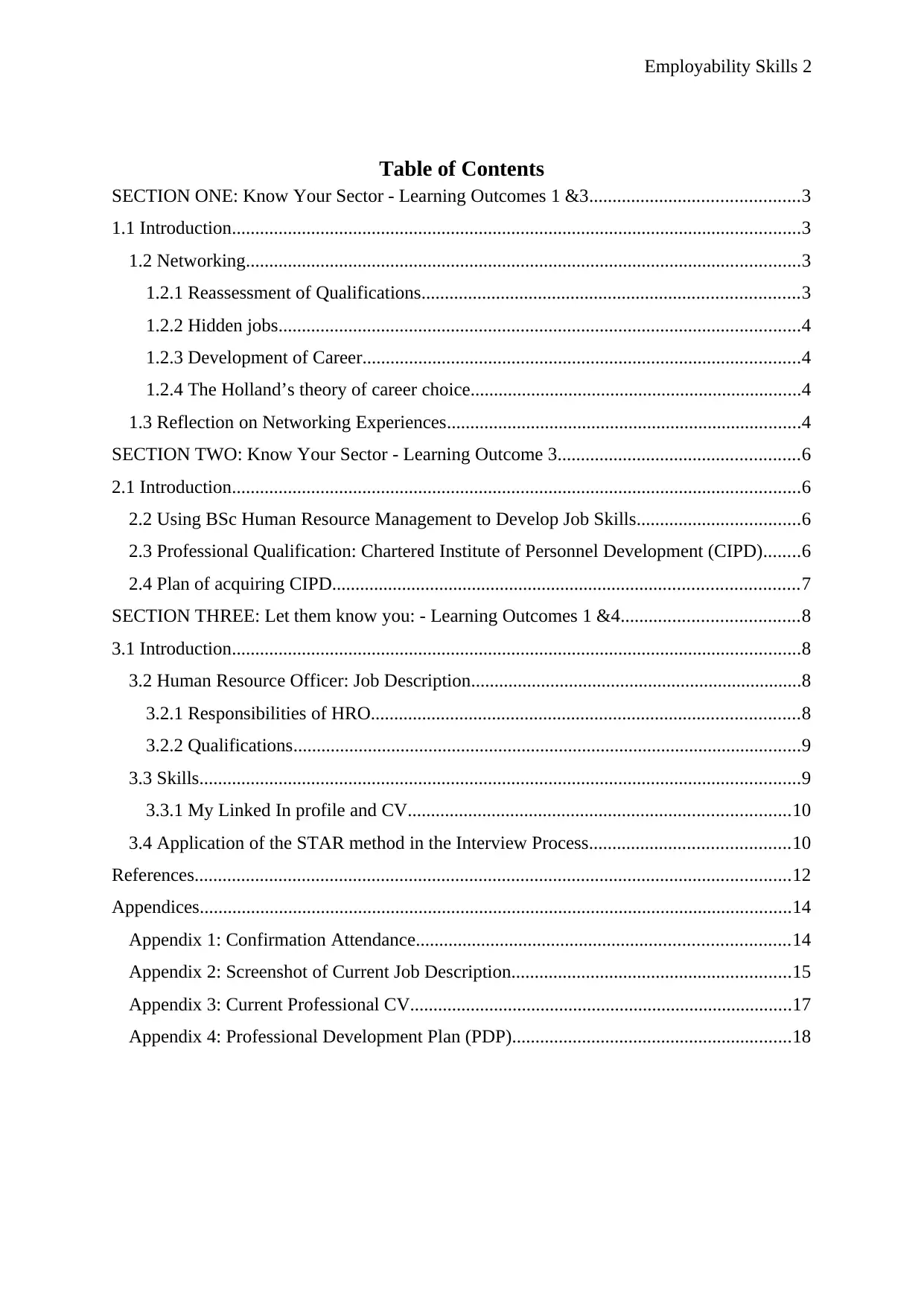
Employability Skills 2
Table of Contents
SECTION ONE: Know Your Sector - Learning Outcomes 1 &3.............................................3
1.1 Introduction..........................................................................................................................3
1.2 Networking.......................................................................................................................3
1.2.1 Reassessment of Qualifications.................................................................................3
1.2.2 Hidden jobs................................................................................................................4
1.2.3 Development of Career..............................................................................................4
1.2.4 The Holland’s theory of career choice.......................................................................4
1.3 Reflection on Networking Experiences............................................................................4
SECTION TWO: Know Your Sector - Learning Outcome 3....................................................6
2.1 Introduction..........................................................................................................................6
2.2 Using BSc Human Resource Management to Develop Job Skills...................................6
2.3 Professional Qualification: Chartered Institute of Personnel Development (CIPD)........6
2.4 Plan of acquiring CIPD....................................................................................................7
SECTION THREE: Let them know you: - Learning Outcomes 1 &4......................................8
3.1 Introduction..........................................................................................................................8
3.2 Human Resource Officer: Job Description.......................................................................8
3.2.1 Responsibilities of HRO............................................................................................8
3.2.2 Qualifications.............................................................................................................9
3.3 Skills.................................................................................................................................9
3.3.1 My Linked In profile and CV..................................................................................10
3.4 Application of the STAR method in the Interview Process...........................................10
References................................................................................................................................12
Appendices...............................................................................................................................14
Appendix 1: Confirmation Attendance................................................................................14
Appendix 2: Screenshot of Current Job Description............................................................15
Appendix 3: Current Professional CV..................................................................................17
Appendix 4: Professional Development Plan (PDP)............................................................18
Table of Contents
SECTION ONE: Know Your Sector - Learning Outcomes 1 &3.............................................3
1.1 Introduction..........................................................................................................................3
1.2 Networking.......................................................................................................................3
1.2.1 Reassessment of Qualifications.................................................................................3
1.2.2 Hidden jobs................................................................................................................4
1.2.3 Development of Career..............................................................................................4
1.2.4 The Holland’s theory of career choice.......................................................................4
1.3 Reflection on Networking Experiences............................................................................4
SECTION TWO: Know Your Sector - Learning Outcome 3....................................................6
2.1 Introduction..........................................................................................................................6
2.2 Using BSc Human Resource Management to Develop Job Skills...................................6
2.3 Professional Qualification: Chartered Institute of Personnel Development (CIPD)........6
2.4 Plan of acquiring CIPD....................................................................................................7
SECTION THREE: Let them know you: - Learning Outcomes 1 &4......................................8
3.1 Introduction..........................................................................................................................8
3.2 Human Resource Officer: Job Description.......................................................................8
3.2.1 Responsibilities of HRO............................................................................................8
3.2.2 Qualifications.............................................................................................................9
3.3 Skills.................................................................................................................................9
3.3.1 My Linked In profile and CV..................................................................................10
3.4 Application of the STAR method in the Interview Process...........................................10
References................................................................................................................................12
Appendices...............................................................................................................................14
Appendix 1: Confirmation Attendance................................................................................14
Appendix 2: Screenshot of Current Job Description............................................................15
Appendix 3: Current Professional CV..................................................................................17
Appendix 4: Professional Development Plan (PDP)............................................................18
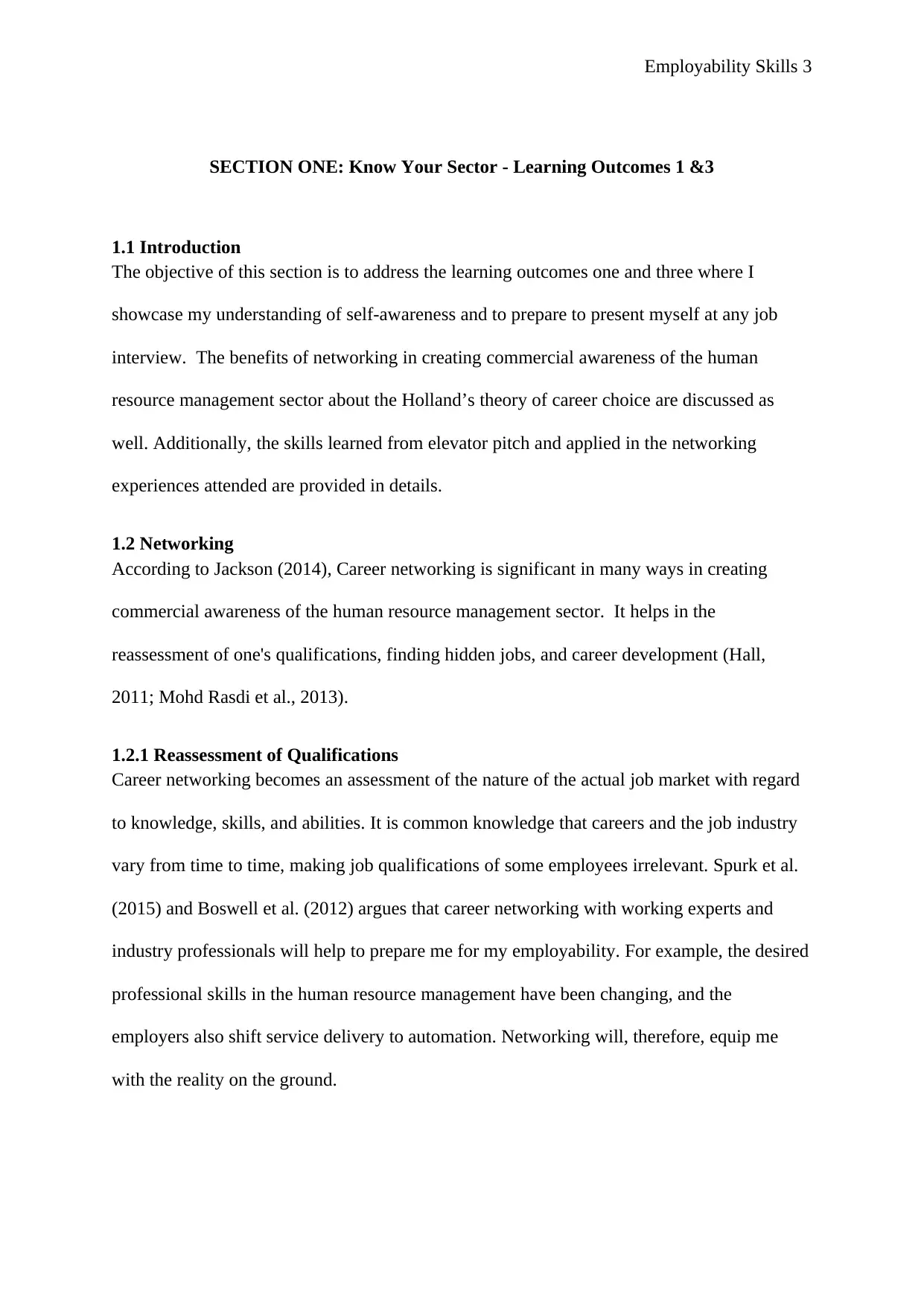
Employability Skills 3
SECTION ONE: Know Your Sector - Learning Outcomes 1 &3
1.1 Introduction
The objective of this section is to address the learning outcomes one and three where I
showcase my understanding of self-awareness and to prepare to present myself at any job
interview. The benefits of networking in creating commercial awareness of the human
resource management sector about the Holland’s theory of career choice are discussed as
well. Additionally, the skills learned from elevator pitch and applied in the networking
experiences attended are provided in details.
1.2 Networking
According to Jackson (2014), Career networking is significant in many ways in creating
commercial awareness of the human resource management sector. It helps in the
reassessment of one's qualifications, finding hidden jobs, and career development (Hall,
2011; Mohd Rasdi et al., 2013).
1.2.1 Reassessment of Qualifications
Career networking becomes an assessment of the nature of the actual job market with regard
to knowledge, skills, and abilities. It is common knowledge that careers and the job industry
vary from time to time, making job qualifications of some employees irrelevant. Spurk et al.
(2015) and Boswell et al. (2012) argues that career networking with working experts and
industry professionals will help to prepare me for my employability. For example, the desired
professional skills in the human resource management have been changing, and the
employers also shift service delivery to automation. Networking will, therefore, equip me
with the reality on the ground.
SECTION ONE: Know Your Sector - Learning Outcomes 1 &3
1.1 Introduction
The objective of this section is to address the learning outcomes one and three where I
showcase my understanding of self-awareness and to prepare to present myself at any job
interview. The benefits of networking in creating commercial awareness of the human
resource management sector about the Holland’s theory of career choice are discussed as
well. Additionally, the skills learned from elevator pitch and applied in the networking
experiences attended are provided in details.
1.2 Networking
According to Jackson (2014), Career networking is significant in many ways in creating
commercial awareness of the human resource management sector. It helps in the
reassessment of one's qualifications, finding hidden jobs, and career development (Hall,
2011; Mohd Rasdi et al., 2013).
1.2.1 Reassessment of Qualifications
Career networking becomes an assessment of the nature of the actual job market with regard
to knowledge, skills, and abilities. It is common knowledge that careers and the job industry
vary from time to time, making job qualifications of some employees irrelevant. Spurk et al.
(2015) and Boswell et al. (2012) argues that career networking with working experts and
industry professionals will help to prepare me for my employability. For example, the desired
professional skills in the human resource management have been changing, and the
employers also shift service delivery to automation. Networking will, therefore, equip me
with the reality on the ground.
⊘ This is a preview!⊘
Do you want full access?
Subscribe today to unlock all pages.

Trusted by 1+ million students worldwide
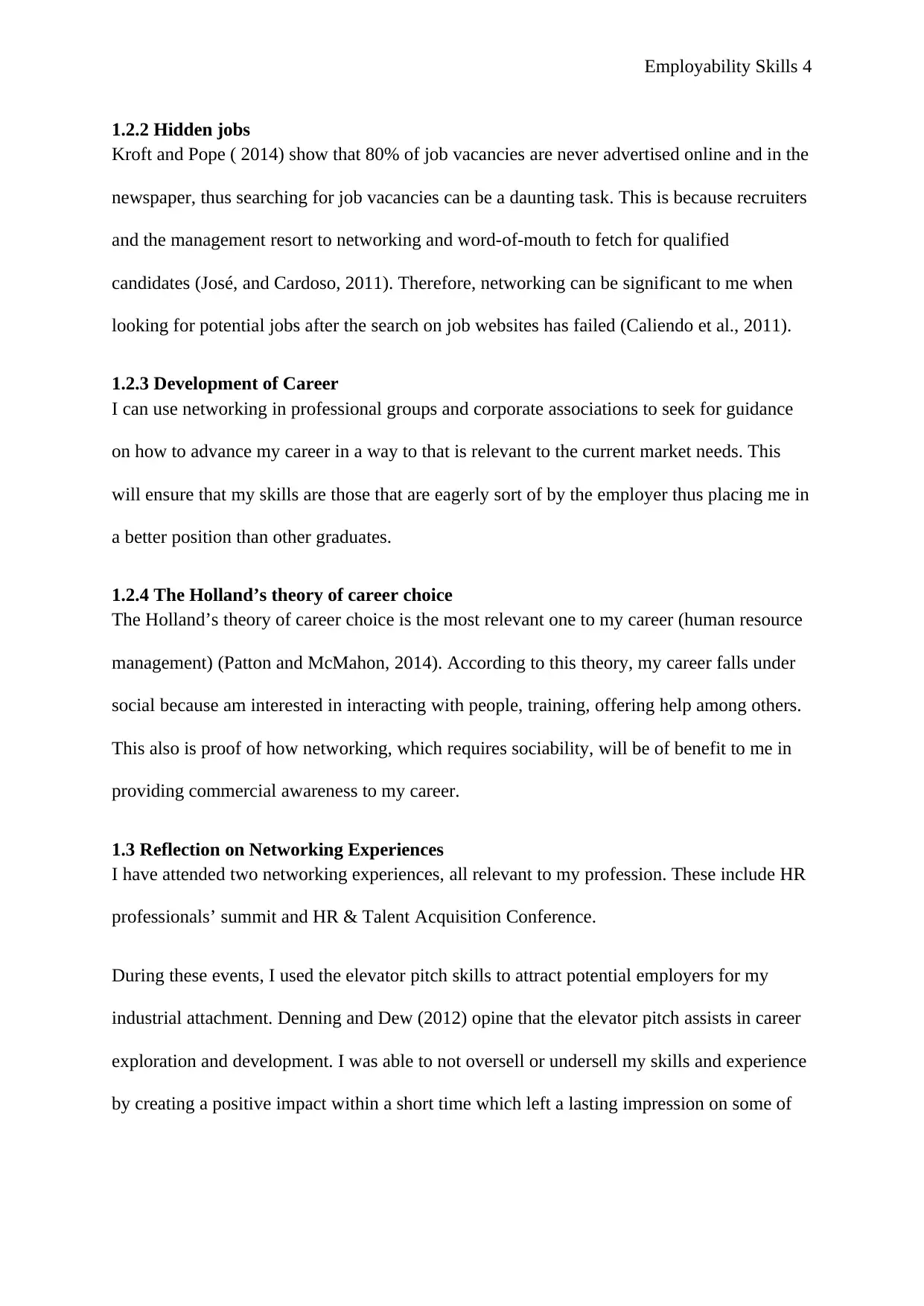
Employability Skills 4
1.2.2 Hidden jobs
Kroft and Pope ( 2014) show that 80% of job vacancies are never advertised online and in the
newspaper, thus searching for job vacancies can be a daunting task. This is because recruiters
and the management resort to networking and word-of-mouth to fetch for qualified
candidates (José, and Cardoso, 2011). Therefore, networking can be significant to me when
looking for potential jobs after the search on job websites has failed (Caliendo et al., 2011).
1.2.3 Development of Career
I can use networking in professional groups and corporate associations to seek for guidance
on how to advance my career in a way to that is relevant to the current market needs. This
will ensure that my skills are those that are eagerly sort of by the employer thus placing me in
a better position than other graduates.
1.2.4 The Holland’s theory of career choice
The Holland’s theory of career choice is the most relevant one to my career (human resource
management) (Patton and McMahon, 2014). According to this theory, my career falls under
social because am interested in interacting with people, training, offering help among others.
This also is proof of how networking, which requires sociability, will be of benefit to me in
providing commercial awareness to my career.
1.3 Reflection on Networking Experiences
I have attended two networking experiences, all relevant to my profession. These include HR
professionals’ summit and HR & Talent Acquisition Conference.
During these events, I used the elevator pitch skills to attract potential employers for my
industrial attachment. Denning and Dew (2012) opine that the elevator pitch assists in career
exploration and development. I was able to not oversell or undersell my skills and experience
by creating a positive impact within a short time which left a lasting impression on some of
1.2.2 Hidden jobs
Kroft and Pope ( 2014) show that 80% of job vacancies are never advertised online and in the
newspaper, thus searching for job vacancies can be a daunting task. This is because recruiters
and the management resort to networking and word-of-mouth to fetch for qualified
candidates (José, and Cardoso, 2011). Therefore, networking can be significant to me when
looking for potential jobs after the search on job websites has failed (Caliendo et al., 2011).
1.2.3 Development of Career
I can use networking in professional groups and corporate associations to seek for guidance
on how to advance my career in a way to that is relevant to the current market needs. This
will ensure that my skills are those that are eagerly sort of by the employer thus placing me in
a better position than other graduates.
1.2.4 The Holland’s theory of career choice
The Holland’s theory of career choice is the most relevant one to my career (human resource
management) (Patton and McMahon, 2014). According to this theory, my career falls under
social because am interested in interacting with people, training, offering help among others.
This also is proof of how networking, which requires sociability, will be of benefit to me in
providing commercial awareness to my career.
1.3 Reflection on Networking Experiences
I have attended two networking experiences, all relevant to my profession. These include HR
professionals’ summit and HR & Talent Acquisition Conference.
During these events, I used the elevator pitch skills to attract potential employers for my
industrial attachment. Denning and Dew (2012) opine that the elevator pitch assists in career
exploration and development. I was able to not oversell or undersell my skills and experience
by creating a positive impact within a short time which left a lasting impression on some of
Paraphrase This Document
Need a fresh take? Get an instant paraphrase of this document with our AI Paraphraser

Employability Skills 5
the potential employers. I also employed practical communication skills in delivering my
elevator pitch.
the potential employers. I also employed practical communication skills in delivering my
elevator pitch.

Employability Skills 6
SECTION TWO: Know Your Sector - Learning Outcome 3
2.1 Introduction
This section comprises of learning outcome three, and it details the relevance of my degree
programme in attaining the required job skills. An analysis of CIPD is also provided
alongside a discussion of my plan to secure the professional qualification.
2.2 Using BSc Human Resource Management to Develop Job Skills
There are several ways I can use my degree programme to develop a broad perspective of my
career and avoid the common linear problems associated with most graduates.
I can use the degree programme to acquire Analytical skills through the debates, case
analyses, and determining the inconsistencies that I engage in under the degree program.
Also, through the elevator pitch learned in the course I can learn written and verbal
communication skills even though the group discussions that am usually involved in with my
colleagues. Through the research project that is mandatory in my degree program, I can
develop investigative skills by researching and assembling study literature and supporting my
arguments. Similarly, through analyzing data in my study research, I can develop numeracy
skills. Through the group assignments that are routinely given by my lecturers, I can gain
teamwork skills. Information technology skills can as well be acquired through the use of the
internet for research while accomplishing my assignments.
2.3 Professional Qualification: Chartered Institute of Personnel Development (CIPD)
I prefer to take the HR professional qualification from CIPD because it is the main
professional body accredited to offer the professional HR qualifications. Its qualifications are
globally recognized as the professional standard for the industry. I, therefore, prefer the
course because of its excellent reputation.
SECTION TWO: Know Your Sector - Learning Outcome 3
2.1 Introduction
This section comprises of learning outcome three, and it details the relevance of my degree
programme in attaining the required job skills. An analysis of CIPD is also provided
alongside a discussion of my plan to secure the professional qualification.
2.2 Using BSc Human Resource Management to Develop Job Skills
There are several ways I can use my degree programme to develop a broad perspective of my
career and avoid the common linear problems associated with most graduates.
I can use the degree programme to acquire Analytical skills through the debates, case
analyses, and determining the inconsistencies that I engage in under the degree program.
Also, through the elevator pitch learned in the course I can learn written and verbal
communication skills even though the group discussions that am usually involved in with my
colleagues. Through the research project that is mandatory in my degree program, I can
develop investigative skills by researching and assembling study literature and supporting my
arguments. Similarly, through analyzing data in my study research, I can develop numeracy
skills. Through the group assignments that are routinely given by my lecturers, I can gain
teamwork skills. Information technology skills can as well be acquired through the use of the
internet for research while accomplishing my assignments.
2.3 Professional Qualification: Chartered Institute of Personnel Development (CIPD)
I prefer to take the HR professional qualification from CIPD because it is the main
professional body accredited to offer the professional HR qualifications. Its qualifications are
globally recognized as the professional standard for the industry. I, therefore, prefer the
course because of its excellent reputation.
⊘ This is a preview!⊘
Do you want full access?
Subscribe today to unlock all pages.

Trusted by 1+ million students worldwide

Employability Skills 7
The It will not only offer me the required knowledge and skills that is needful in the
workplace but also make me all rounded and more knowledgeable in HR. Trends in the job
industry also show that employers prefer candidates to have at least a single CIPD
qualification. It also becomes a specific career enhancer and makes my CV look more
credible in the sight of the employers.
2.4 Plan of acquiring CIPD
I plan to pursue the advanced level of CIPD with learning and development focus while
working. This is because I plan to develop strategic understanding of personnel management.
The qualifications attained will add the following value to the employer thus making me the
most favorable candidate:
I will be able to achieve significant career development skills and improve the status of my
professionalism because the course paves the way towards my chartered membership.
I will also be of value to the employer because the course will enable me to learn how to
establish HRM strategies, policies, procedures, and effective programmes within a dynamic
business context.
The course will also equip me for problem-solving and concentrate on areas in HRM where I
can offer a competitive advantage to the corporation.
The It will not only offer me the required knowledge and skills that is needful in the
workplace but also make me all rounded and more knowledgeable in HR. Trends in the job
industry also show that employers prefer candidates to have at least a single CIPD
qualification. It also becomes a specific career enhancer and makes my CV look more
credible in the sight of the employers.
2.4 Plan of acquiring CIPD
I plan to pursue the advanced level of CIPD with learning and development focus while
working. This is because I plan to develop strategic understanding of personnel management.
The qualifications attained will add the following value to the employer thus making me the
most favorable candidate:
I will be able to achieve significant career development skills and improve the status of my
professionalism because the course paves the way towards my chartered membership.
I will also be of value to the employer because the course will enable me to learn how to
establish HRM strategies, policies, procedures, and effective programmes within a dynamic
business context.
The course will also equip me for problem-solving and concentrate on areas in HRM where I
can offer a competitive advantage to the corporation.
Paraphrase This Document
Need a fresh take? Get an instant paraphrase of this document with our AI Paraphraser
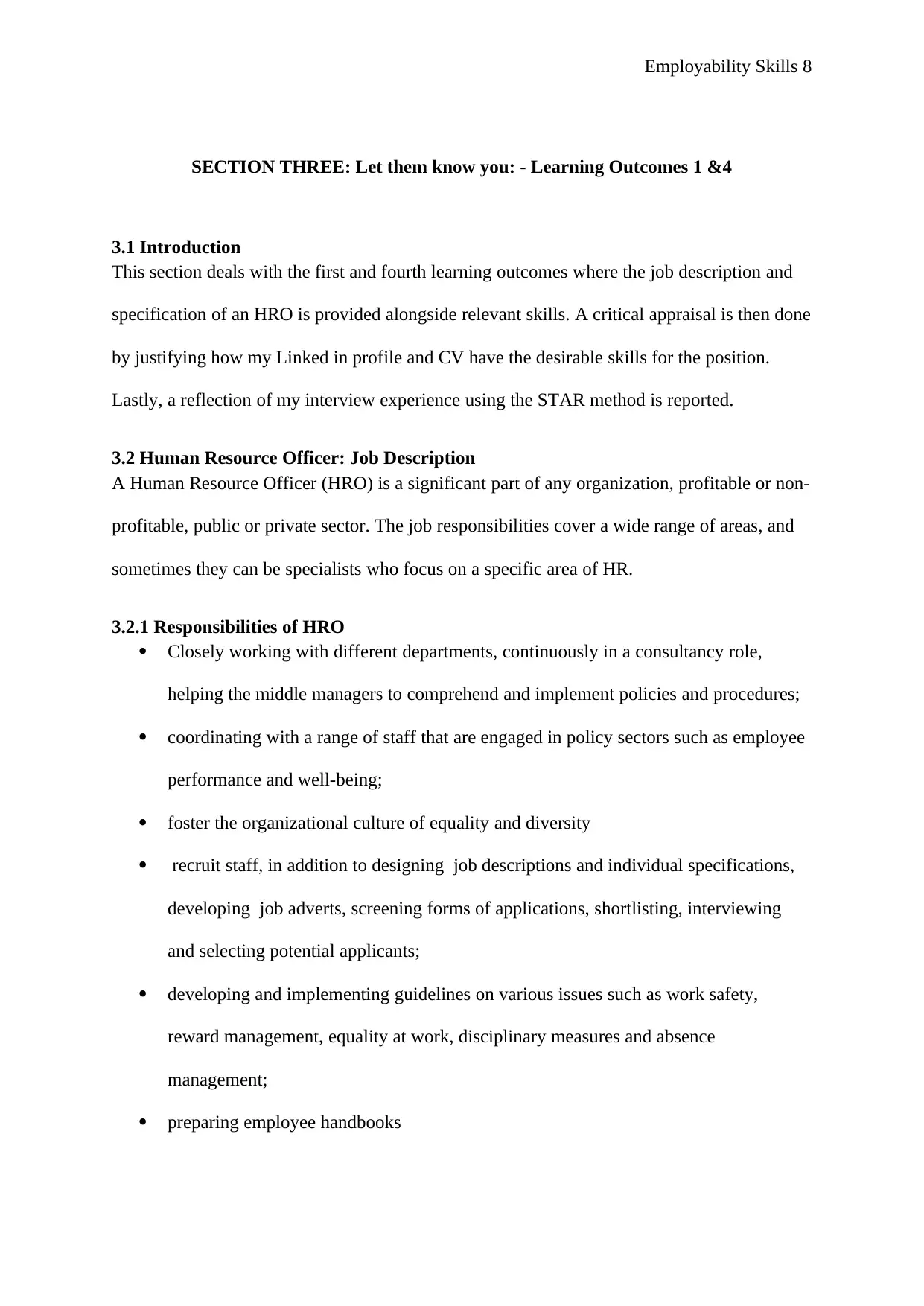
Employability Skills 8
SECTION THREE: Let them know you: - Learning Outcomes 1 &4
3.1 Introduction
This section deals with the first and fourth learning outcomes where the job description and
specification of an HRO is provided alongside relevant skills. A critical appraisal is then done
by justifying how my Linked in profile and CV have the desirable skills for the position.
Lastly, a reflection of my interview experience using the STAR method is reported.
3.2 Human Resource Officer: Job Description
A Human Resource Officer (HRO) is a significant part of any organization, profitable or non-
profitable, public or private sector. The job responsibilities cover a wide range of areas, and
sometimes they can be specialists who focus on a specific area of HR.
3.2.1 Responsibilities of HRO
Closely working with different departments, continuously in a consultancy role,
helping the middle managers to comprehend and implement policies and procedures;
coordinating with a range of staff that are engaged in policy sectors such as employee
performance and well-being;
foster the organizational culture of equality and diversity
recruit staff, in addition to designing job descriptions and individual specifications,
developing job adverts, screening forms of applications, shortlisting, interviewing
and selecting potential applicants;
developing and implementing guidelines on various issues such as work safety,
reward management, equality at work, disciplinary measures and absence
management;
preparing employee handbooks
SECTION THREE: Let them know you: - Learning Outcomes 1 &4
3.1 Introduction
This section deals with the first and fourth learning outcomes where the job description and
specification of an HRO is provided alongside relevant skills. A critical appraisal is then done
by justifying how my Linked in profile and CV have the desirable skills for the position.
Lastly, a reflection of my interview experience using the STAR method is reported.
3.2 Human Resource Officer: Job Description
A Human Resource Officer (HRO) is a significant part of any organization, profitable or non-
profitable, public or private sector. The job responsibilities cover a wide range of areas, and
sometimes they can be specialists who focus on a specific area of HR.
3.2.1 Responsibilities of HRO
Closely working with different departments, continuously in a consultancy role,
helping the middle managers to comprehend and implement policies and procedures;
coordinating with a range of staff that are engaged in policy sectors such as employee
performance and well-being;
foster the organizational culture of equality and diversity
recruit staff, in addition to designing job descriptions and individual specifications,
developing job adverts, screening forms of applications, shortlisting, interviewing
and selecting potential applicants;
developing and implementing guidelines on various issues such as work safety,
reward management, equality at work, disciplinary measures and absence
management;
preparing employee handbooks

Employability Skills 9
providing counsel on remuneration and other payment issues, as well as promotion
and perks;
carrying our reviews routinely;
Negotiating with the employees and their representatives such as the labor unions on
matters of pay and work conditions.
3.2.2 Qualifications
The HRO position is usually open to all undergraduates or with an additional higher national
diploma (HND); however, the employer may be categorical on the following subjects:
Human resource management
Business or management
Business alongside languages
3.3 Skills
Ability to handle the leadership role
Conscious of business and management skills
Persuasive and negotiation skills to implement individual policies
The potential to compile and analyze statistical data and communicate it in a
particular and understandable way
Corporate skills and the ability to comprehend in-depth information
Necessary IT and numeracy skills needed for the management of employee
computerized payroll and perk systems
Inter-personal skills to develop good work relationships with all the staff
The potential to examine and interpret relevant labor laws
Honesty and accessibility because the management and the employees must be free
with you to discuss private and confidential matters
providing counsel on remuneration and other payment issues, as well as promotion
and perks;
carrying our reviews routinely;
Negotiating with the employees and their representatives such as the labor unions on
matters of pay and work conditions.
3.2.2 Qualifications
The HRO position is usually open to all undergraduates or with an additional higher national
diploma (HND); however, the employer may be categorical on the following subjects:
Human resource management
Business or management
Business alongside languages
3.3 Skills
Ability to handle the leadership role
Conscious of business and management skills
Persuasive and negotiation skills to implement individual policies
The potential to compile and analyze statistical data and communicate it in a
particular and understandable way
Corporate skills and the ability to comprehend in-depth information
Necessary IT and numeracy skills needed for the management of employee
computerized payroll and perk systems
Inter-personal skills to develop good work relationships with all the staff
The potential to examine and interpret relevant labor laws
Honesty and accessibility because the management and the employees must be free
with you to discuss private and confidential matters
⊘ This is a preview!⊘
Do you want full access?
Subscribe today to unlock all pages.

Trusted by 1+ million students worldwide
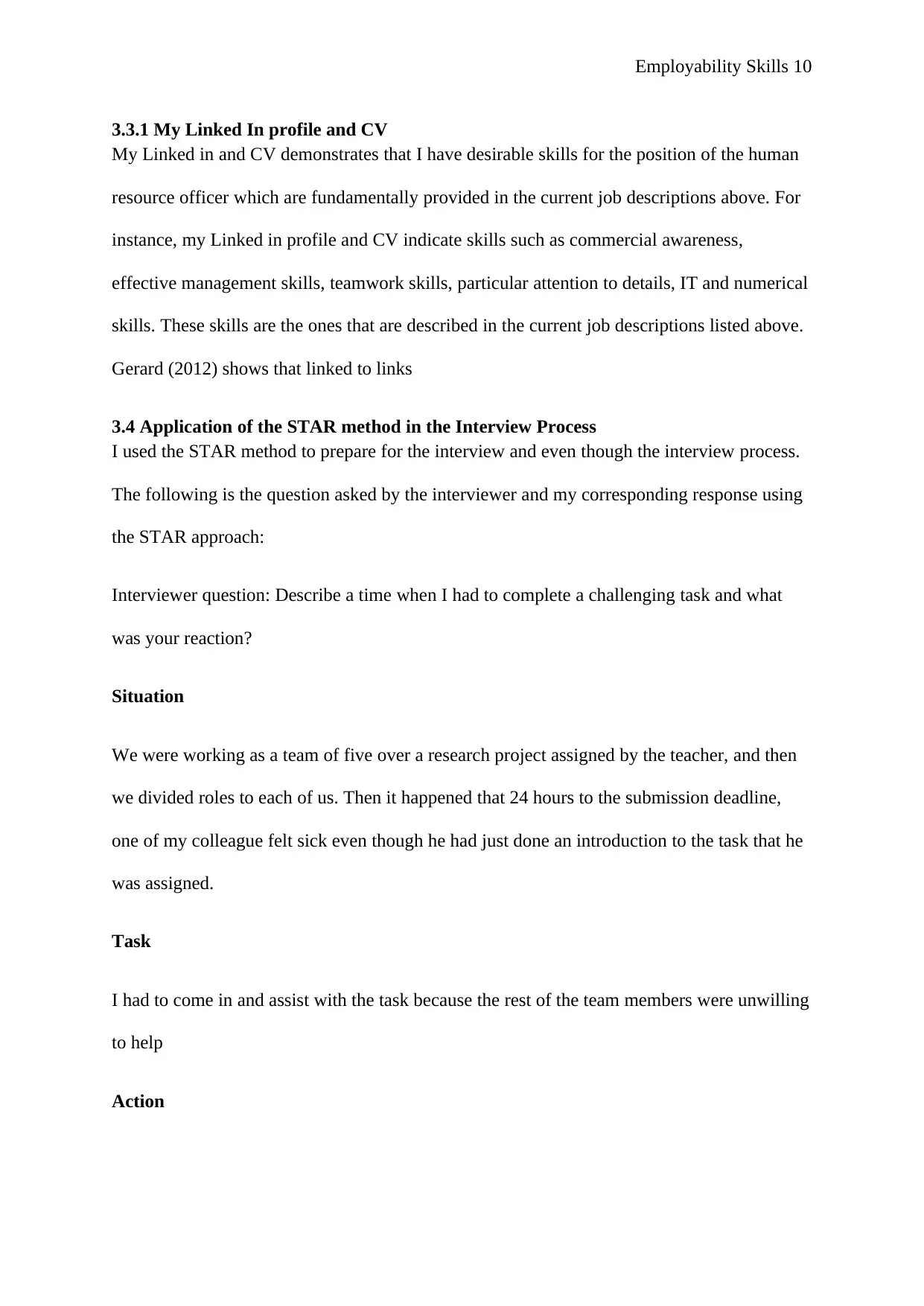
Employability Skills 10
3.3.1 My Linked In profile and CV
My Linked in and CV demonstrates that I have desirable skills for the position of the human
resource officer which are fundamentally provided in the current job descriptions above. For
instance, my Linked in profile and CV indicate skills such as commercial awareness,
effective management skills, teamwork skills, particular attention to details, IT and numerical
skills. These skills are the ones that are described in the current job descriptions listed above.
Gerard (2012) shows that linked to links
3.4 Application of the STAR method in the Interview Process
I used the STAR method to prepare for the interview and even though the interview process.
The following is the question asked by the interviewer and my corresponding response using
the STAR approach:
Interviewer question: Describe a time when I had to complete a challenging task and what
was your reaction?
Situation
We were working as a team of five over a research project assigned by the teacher, and then
we divided roles to each of us. Then it happened that 24 hours to the submission deadline,
one of my colleague felt sick even though he had just done an introduction to the task that he
was assigned.
Task
I had to come in and assist with the task because the rest of the team members were unwilling
to help
Action
3.3.1 My Linked In profile and CV
My Linked in and CV demonstrates that I have desirable skills for the position of the human
resource officer which are fundamentally provided in the current job descriptions above. For
instance, my Linked in profile and CV indicate skills such as commercial awareness,
effective management skills, teamwork skills, particular attention to details, IT and numerical
skills. These skills are the ones that are described in the current job descriptions listed above.
Gerard (2012) shows that linked to links
3.4 Application of the STAR method in the Interview Process
I used the STAR method to prepare for the interview and even though the interview process.
The following is the question asked by the interviewer and my corresponding response using
the STAR approach:
Interviewer question: Describe a time when I had to complete a challenging task and what
was your reaction?
Situation
We were working as a team of five over a research project assigned by the teacher, and then
we divided roles to each of us. Then it happened that 24 hours to the submission deadline,
one of my colleague felt sick even though he had just done an introduction to the task that he
was assigned.
Task
I had to come in and assist with the task because the rest of the team members were unwilling
to help
Action
Paraphrase This Document
Need a fresh take? Get an instant paraphrase of this document with our AI Paraphraser

Employability Skills 11
I took the partial part that the sick team-mate had done and rushed to the school library even
though I was on my way home from class. I sat down or the next five hours and had to
research and compile the research project.
Result
I was able to get home though late, but the following I was able to submit a complete and
compiled report for our team without which non-of us could graduate.
I took the partial part that the sick team-mate had done and rushed to the school library even
though I was on my way home from class. I sat down or the next five hours and had to
research and compile the research project.
Result
I was able to get home though late, but the following I was able to submit a complete and
compiled report for our team without which non-of us could graduate.
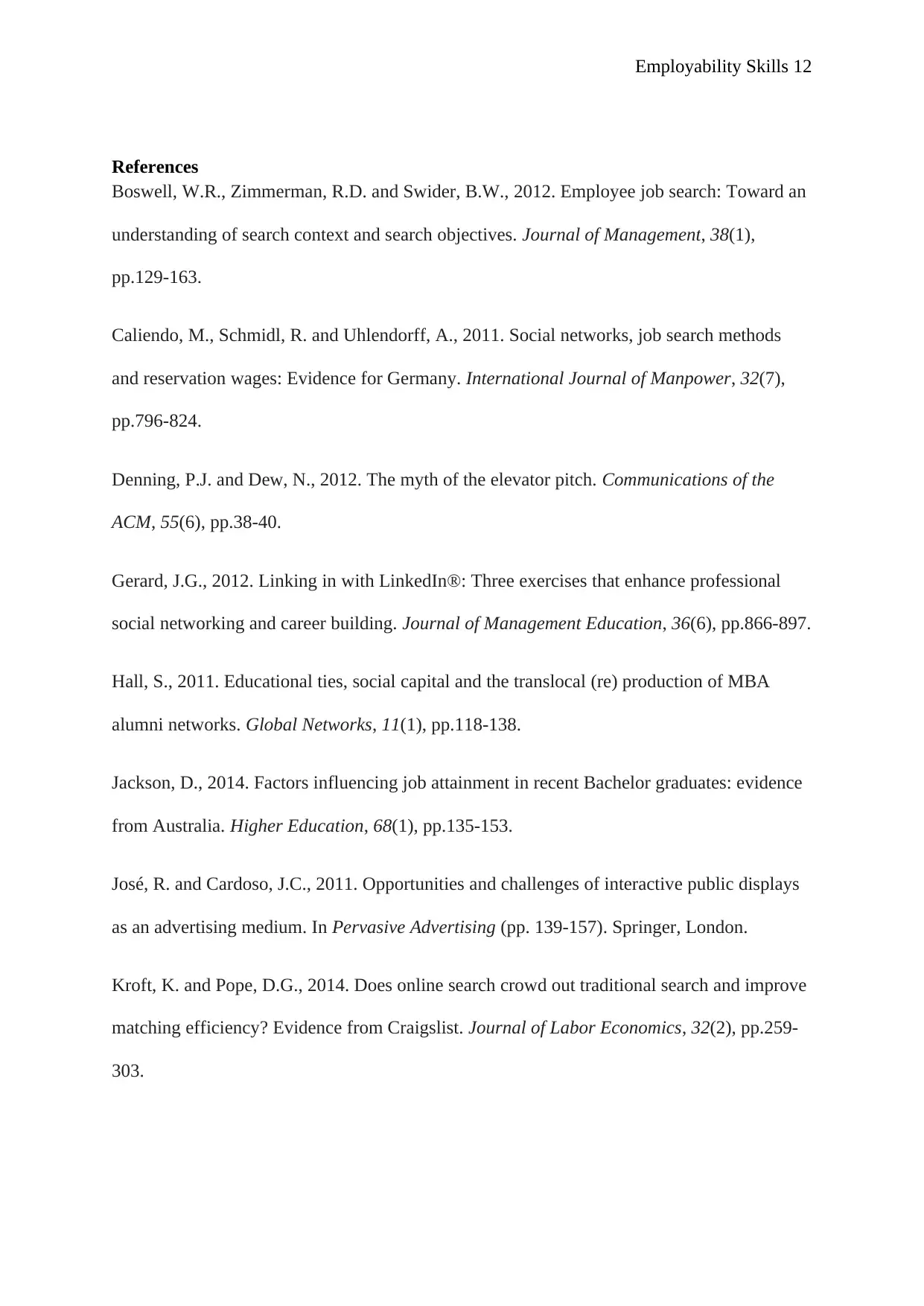
Employability Skills 12
References
Boswell, W.R., Zimmerman, R.D. and Swider, B.W., 2012. Employee job search: Toward an
understanding of search context and search objectives. Journal of Management, 38(1),
pp.129-163.
Caliendo, M., Schmidl, R. and Uhlendorff, A., 2011. Social networks, job search methods
and reservation wages: Evidence for Germany. International Journal of Manpower, 32(7),
pp.796-824.
Denning, P.J. and Dew, N., 2012. The myth of the elevator pitch. Communications of the
ACM, 55(6), pp.38-40.
Gerard, J.G., 2012. Linking in with LinkedIn®: Three exercises that enhance professional
social networking and career building. Journal of Management Education, 36(6), pp.866-897.
Hall, S., 2011. Educational ties, social capital and the translocal (re) production of MBA
alumni networks. Global Networks, 11(1), pp.118-138.
Jackson, D., 2014. Factors influencing job attainment in recent Bachelor graduates: evidence
from Australia. Higher Education, 68(1), pp.135-153.
José, R. and Cardoso, J.C., 2011. Opportunities and challenges of interactive public displays
as an advertising medium. In Pervasive Advertising (pp. 139-157). Springer, London.
Kroft, K. and Pope, D.G., 2014. Does online search crowd out traditional search and improve
matching efficiency? Evidence from Craigslist. Journal of Labor Economics, 32(2), pp.259-
303.
References
Boswell, W.R., Zimmerman, R.D. and Swider, B.W., 2012. Employee job search: Toward an
understanding of search context and search objectives. Journal of Management, 38(1),
pp.129-163.
Caliendo, M., Schmidl, R. and Uhlendorff, A., 2011. Social networks, job search methods
and reservation wages: Evidence for Germany. International Journal of Manpower, 32(7),
pp.796-824.
Denning, P.J. and Dew, N., 2012. The myth of the elevator pitch. Communications of the
ACM, 55(6), pp.38-40.
Gerard, J.G., 2012. Linking in with LinkedIn®: Three exercises that enhance professional
social networking and career building. Journal of Management Education, 36(6), pp.866-897.
Hall, S., 2011. Educational ties, social capital and the translocal (re) production of MBA
alumni networks. Global Networks, 11(1), pp.118-138.
Jackson, D., 2014. Factors influencing job attainment in recent Bachelor graduates: evidence
from Australia. Higher Education, 68(1), pp.135-153.
José, R. and Cardoso, J.C., 2011. Opportunities and challenges of interactive public displays
as an advertising medium. In Pervasive Advertising (pp. 139-157). Springer, London.
Kroft, K. and Pope, D.G., 2014. Does online search crowd out traditional search and improve
matching efficiency? Evidence from Craigslist. Journal of Labor Economics, 32(2), pp.259-
303.
⊘ This is a preview!⊘
Do you want full access?
Subscribe today to unlock all pages.

Trusted by 1+ million students worldwide
1 out of 20
Related Documents
Your All-in-One AI-Powered Toolkit for Academic Success.
+13062052269
info@desklib.com
Available 24*7 on WhatsApp / Email
![[object Object]](/_next/static/media/star-bottom.7253800d.svg)
Unlock your academic potential
Copyright © 2020–2025 A2Z Services. All Rights Reserved. Developed and managed by ZUCOL.



